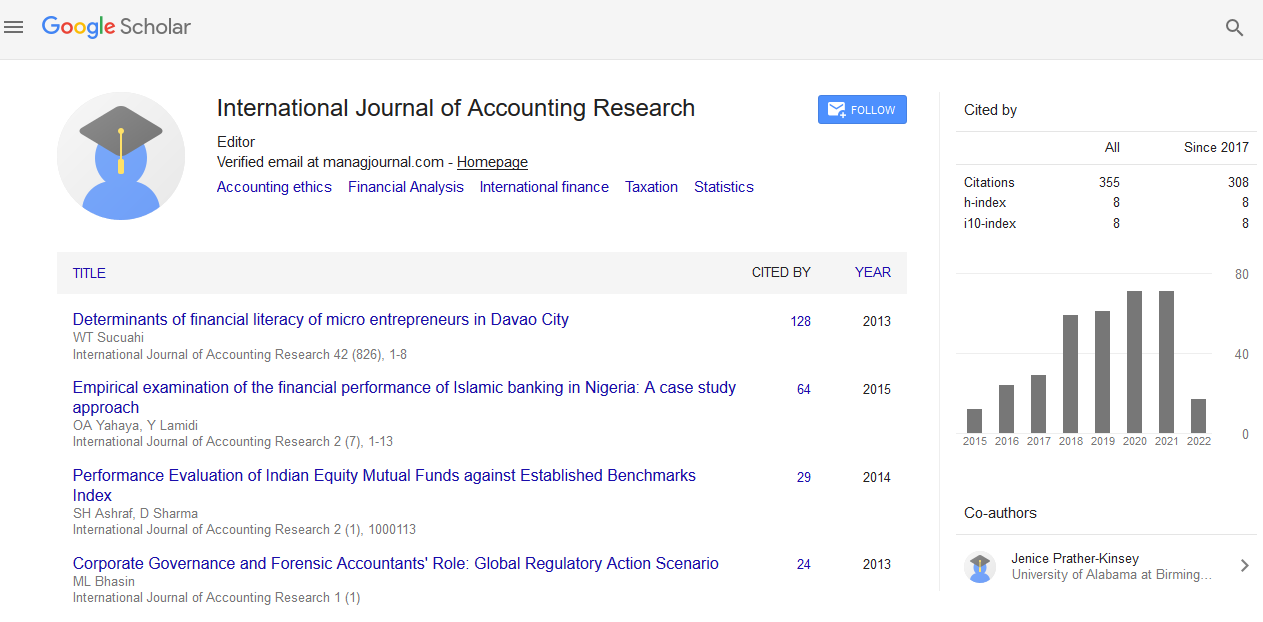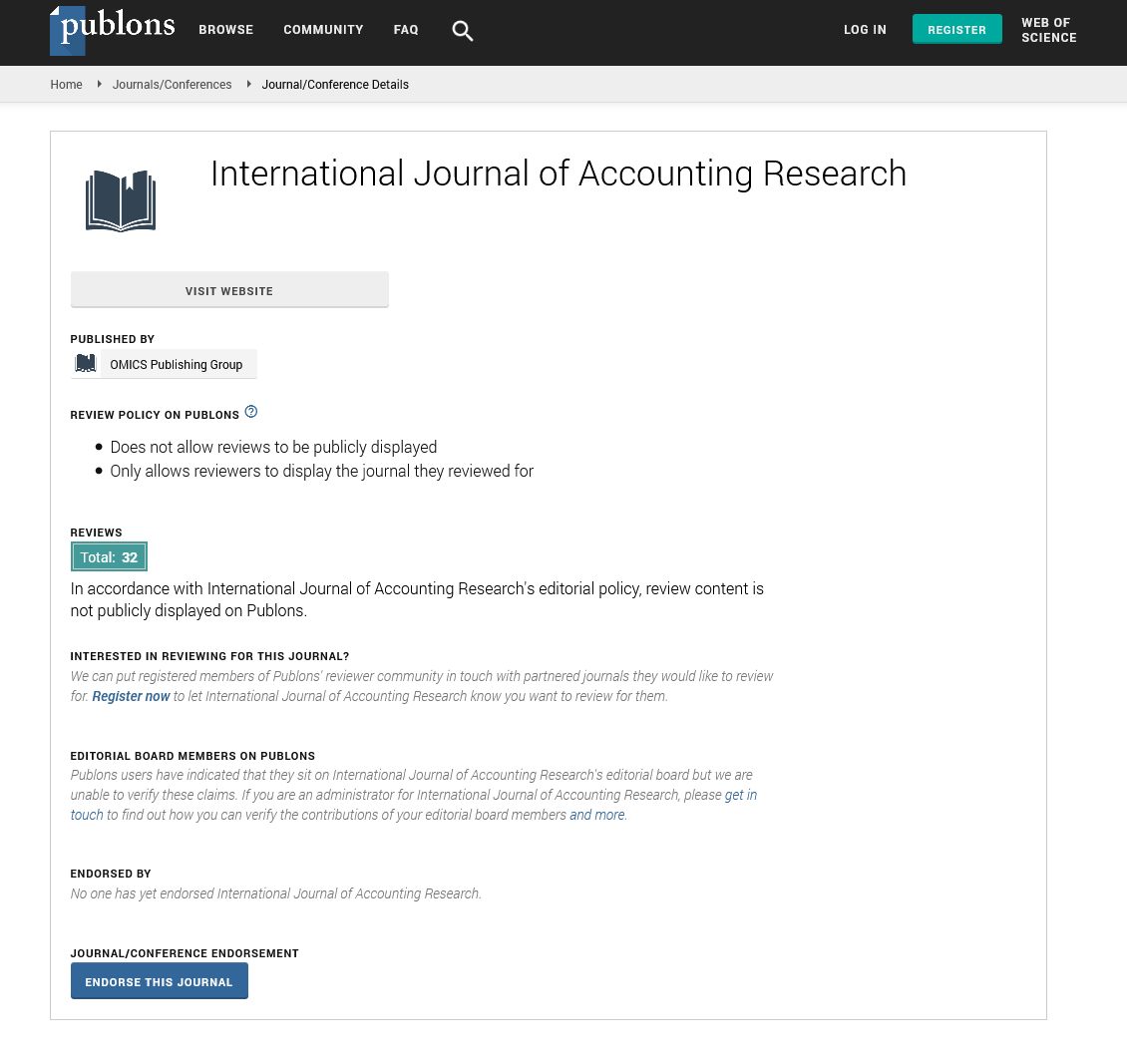Indexed In
- Open J Gate
- RefSeek
- Hamdard University
- EBSCO A-Z
- Scholarsteer
- Publons
- Euro Pub
- Google Scholar
Useful Links
Share This Page
Journal Flyer

Open Access Journals
- Agri and Aquaculture
- Biochemistry
- Bioinformatics & Systems Biology
- Business & Management
- Chemistry
- Clinical Sciences
- Engineering
- Food & Nutrition
- General Science
- Genetics & Molecular Biology
- Immunology & Microbiology
- Medical Sciences
- Neuroscience & Psychology
- Nursing & Health Care
- Pharmaceutical Sciences
Commentary - (2022) Volume 10, Issue 9
Using Network Statistics to Predict Financial Risk Indicators in Market Participants
Rosellen Cardella*Received: 05-Sep-2022, Manuscript No. IJAR-22-18330; Editor assigned: 08-Sep-2022, Pre QC No. IJAR-22-18330 (PQ); Reviewed: 26-Sep-2022, QC No. IJAR-22-18330; Revised: 01-Oct-2022, Manuscript No. IJAR-22-18330 (R); Published: 08-Oct-2022, DOI: 10.35248/2472-114X.22.10.291
Description
Understanding financial insecurity during financial crises is a critical topic in risk management. Risk indicators are actively used by market participants. Which are derived from derivative products, to assess market anxiety and fear and thus estimate market systemic risk designers present the results of an investigation on the lead-lag relationship between financial connectedness and risk indicators. The risk indicators' predictive power of time-varying network statistics compiled from over 1300 stocks from international stock markets The empirical findings support the use of network statistics to predict risk indicators. The findings highlight the significance of network connectivity in assessing systemic risk. How financial institutions assess systemic risk, or the risk of a possible financial crisis or major financial incident causing a significant breakdown of financial systems, has long been debated, even though significant financial instability may be unavoidable during crisis periods. The recent financial market volatility caused by the Covid-19 pandemic strengthened investors' intentions to engage in risk management and raised their awareness of the importance of good systemic risk measures for risk management. Financial contagion is one of the primary sources of systemic risk. Financial risk can be transferred from one institution to another, causing widespread problems. Network analysis, which has been applied to co-authorship, social networks, and epidemiology, is a natural approach to quantifying and modeling financial contagion and systemic risk.
The use of analysis tools to discuss financial epidemic appears to be a viable approach in the literature as well. Measuring financial network connectedness is a useful technique for objectively assessing the impact of financial contagion and systemic risk in financial markets. Financial connectedness is linked to financial contagion and is regarded as one of the most useful indicators for quantifying systemic risk in financial markets. During a crisis, the interconnectedness of financial institutions, combined with global financial integration, causes risk from the crisis to spread across multiple markets around the world. Such disasters not only expose the entire financial system to the risk of a risk spillover effect, but they also expose the theoretical relationships between risk, financial stability, and system connectivity. As a result, network analysis is widely used in financial research. A network, which consists of individual nodes and edges that connect different nodes, which describes how a system forms and how information is transmitted within the system. Financial network characteristics can reflect financial interconnectedness and systemic risk.
Volatility indices are commonly used to track market risk and anxiety. Volatility, which has the potential to transmit systemic risk and exacerbate the crisis in financial markets, is closely related to systemic risk and can be used as an indicator to reflect systemic risk. As a widely used indicator of market fears, VIX has been used as an important indicator to measure systemic risk and has always served as a common determinant of market systemic risk. During a crisis, rather than absorbing shocks as is normal, financial interconnectedness may cause shocks to increase and propagate in the system, increasing systemic risk in financial systems. In other words, a causal relationship may exist between financial connectedness and common risk indicators such as VIX, and that connectedness may result in a predictive power of the connectedness to predict systemic risk. The causality test was used to detect any significant lead-lag relationships among the returns of over 1300 stocks from various international stock markets. Dynamic financial networks were built using the lead-lag relationship. This empirical analysis is divided into three sections. To begin, people investigated the time-series properties of financial networks. The financial networks were built using the causality test, and the networks' evolution was studied over time, particularly during financial crises. Second, undertaken a within-region analysis to see if there was a link between the risk indicators VIX and their financial market connectedness in the United States, Asia, and Europe, respectively. This within-region analysis provided insight into whether risk indicators could be predicted using network statistics. A cross-regional analysis was conducted to determine whether there was a causal relationship between the VIX and other regions' financial market connectedness. There is strong evidence of predictive power for risk indicators in those within-region and cross-regional analyses based on network statistics in crisis periods.
Obviously, have concentrated on one of two goals. Measuring connectedness or measuring systemic risk. The majority of those focusing on measuring connectedness focused on how to measure connectedness and how insightful connectedness indicators are, with only a few quantifying systemic risk. Few people cared about the connectedness when it came to systemic risk measurements. Improved understanding of the financial system's interconnectedness as well as systemic risk in the global stock market. On the interconnectedness front, the connectedness was measured using correlation networks, with edges based on asset return correlations. The Causality test was used to identify the relationship between interconnectedness and systemic risk in the financial system, which allowed us to better understand how connectedness reflects systemic risk in times of crisis.
Citation: Cardella R (2022) Using Network Statistics to Predict Financial Risk Indicators in Market Participants. Int J Account Res. 10:291.
Copyright: © 2022 Cardella R. This is an open-access article distributed under the terms of the Creative Commons Attribution License, which permits unrestricted use, distribution, and reproduction in any medium, provided the original author and source are credited.


